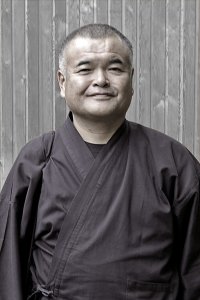Written by Kagita Chūbee, 20th sōke (headmaster) of the Hōzōinryū
Happy new year.
I feel honoured to have the opportunity to write on the sōjutsu of the Hōzōinryū and would be glad if you would follow me through the 12 episodes that will be published here in the course of this year.
The sōjutsu (the art of fencing with spears) of the Hōzōinryū like the kenjutsu (the art of sword fencing) of the Yagyū Shinkageryū is an old martial art (kobudō) which originated in Nara. The founder of the Hōzōinryū was Kakuzenbō Inei who lived at the Hōzōin which was a subtemple to the temple Kōfukuji in Nara. About 450 years ago Inei's spear crossed the reflection of the crescent moon on the the pond Saruzawa-no-ike. Tradition has it that this inspired him to develop techniques with a sickle-spear and finally let him found the Hōzōinryū. The spear which is used in the Hōzōinryu is called kamayari (sickle-spear). In contrast to the ordinary straight spear which is called a suyari the kamayari is distinguished by its cross-shaped blade. Used properly the kamayari is not only good for thrusting but can be used to strike down the opponent's spear in a winding movement (makiotoshi), in a cutting movement (kiriotoshi), to beat it down (uchiotoshi) or to use one of its two sickles to slide along the opponent's spear shaft towards his leading hand (surikomi). This makes the kamayari superior in the offensive as well as the defensive. For this reason the influence of the Hōzōinryū grew strong all over the country in no time and the Hōzōinryū became the largest spear school of Japan. Its spear was praised in the poem:
Thrusting its a spear
Mowing its a pole sword
It can scythe like a sickle
Ad it never fails to hit its target.
The sōjutsu of the Hōzōinryū appears in Yoshikawa Eiji's novel "Musashi", in the manga "Vagabond" and last but not least in the serialized tv drama "Musashi" which was broadcasted by NHK in 2003. For this reason the name of the school is well known to the public.
 At the moment I am the 20th headmaster of the Hōzōinryū which has approximately 100 members alltogether who dedicate themselves to the training at the central budōjō in Nara, in Higashiōsaka, in Nagoya and in Hamburg in Germany.
At the moment I am the 20th headmaster of the Hōzōinryū which has approximately 100 members alltogether who dedicate themselves to the training at the central budōjō in Nara, in Higashiōsaka, in Nagoya and in Hamburg in Germany.
The foundation of old martial arts (kobudō) is the training of forms or choreographed patterns of movements (katageiko) thanks to which fighting techinques more than 400 years old have been handed down until today. Since ancient times there had been fencing and spear techniques in Europe as well. But there such disciplines developed into sports with the focus on winning. The practitioners therefore concentrated solely on the victory in competitions which finally was responsible for the loss of the ancient techniques. In all of the old martial art schools of Japan on the other hand the techniques devised and refined by the ancestors have been handed down until today as they were then through the continuous repetition of the forms. For an average human being it is no easy task to hand down the inherited techniques to the next generation unalteredly. But once there is a break in this tradition it is impossible to reinstate it. To avoid such a break not only is the true fascination of the training of martial arts but it is also a stimulus to all of its trainees.
I was born in 1957 as the second son to Kagita Chūzaburō in Nara. In 1961 my father opened the dōjō Shūshinkan (hall of the education of the heart) in a part of our house where he taught kendō and zen. When I was three years old I became a disciple of this dōjō as if this was the most natural thing in the world. Since then I have followed the path of kendō. When I entered the Nara Ikuei highschool and after that the Kokushikan university I joined the kendō clubs there and spent my life as a student devoted to the martial arts. In a later issue i shall write in detail on the return of the Hōzōinryū sōjutsu to Nara from where it once had disappeared. For now only this much: during my martial arts dedicated student time I had the opportunity to train in Hōzōinryū sōjutsu.
At the moment I have the opportunity to participate in the government of Japan as a member of the lower house (translators remark: since May 2009 Kagita Chūbê was no longer member of the lower house). Being a member of Parliament is an important office as it deals with the affairs of the country. There are 722 Members of Pariament in the lower and the upper house all together. But there is only one headmaster of the Hōzōinryū in all of the world. Since I have assumed the position of headmaster I gave my best to stand up to my task which nearly is impossible to fulfill. But I am really grateful for this heavy burden as it has kept me on my way without erring from it.
(First published in the Nara town magazine Ubusuna on January 5th 2009)